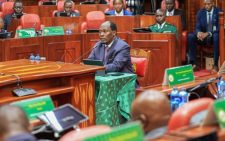Gender gap narrows as more girls enrol in schools, shows report

There are still many girls that are out of school, but there is hope as a new report indicates that the number of girls getting education has been on the upward trend.
For 17-year-old Mercy Sepina*, a Form One student in a secondary school in Samburu, her education journey has been muddled with barbs all the way. From genital female mutilation, forced marriage to a ‘ beading’ culture that have derailed the path of many of her agemates.
“Society and peer pressure have been huge for those who make it beyond Class Five.
Young men and old alike want us out of school,” she laments of her and other girls’, her age, struggles as they await schools resumption, after eight months of closure to curb the spread of coronavirus.
However, while numerous hurdles block the education paths of many girls in northern Kenya, Kajiado, Narok, Kilifi counties as well as Kuria sub-counties among other regions in the country, recent data from the United Nations Education Science and Cultural Organisation (Unesco), indicates that the number of girls getting education globally has been on the rise since 1995.
Unesco reports that more than 180 million more girls have enrolled in primary and secondary education over the 25-year period, highlighting increased inclusion globally.
The global enrolment rate for girls increased from 73 per cent to 89 per cent, with the biggest improvements seen in sub-Saharan Africa.
The report released a fortnight ago, during the International Day of the Girl Child, noted that girls are still more likely to suffer exclusion than boys, and this is further exacerbated by the current pandemic.
It, therefore, remains vital for governments to tackle persisting discrimination to achieve equality for the next generation of girls, argues the Global Education Monitoring (GEM) Report, A New Generation: 25 years of efforts for gender equality in education.
In Kenya, cases of teen pregnancies, forced marriages and Genital Female Mutilation (FGM) have been blamed for lower girls’ school attendance compared to boys.
Bridging gender disparity
For the girls to have increased access to education, numerous players including government agencies and non-governmental organisations have been actively involved in the rescue of girls from outdated practices.
For instance, the World Vision-funded Lorroki Area Programme, Samburu central sub-county has been working to protect and improve access to education of 8,480 girls from the nomadic community.
World Vision says that construction and equipping of five rescue centres among other measures has increased access for girls’ to upper primary education from 2,124 to 3,024 and improved literacy rates from 19.22 per cent to 25 per cent by 2019.
“Girls who have fled their homes need to be able to go to school and have access to support to deal with the violence they may have witnessed or experienced,” says Stephen Omollo, World Vision’s Vice President for East Africa.
Globally, Unesco lauds the progress made, calling for governments and other organisations to do more to bridge the gender disparity in education access.
“Although we are happy to report the progress achieved in girls’ and women’s education through the continued efforts of the international community, this publication also shows we are still failing the most disadvantaged: three-quarters of all primary-age children who may never set foot in school are girls,” said Audrey Azoulay, Unesco director-general.
The report calls for elimination of gender disparity in education access, participation and completion noting that fewer than nine females enrolled for every 10 males in four per cent of countries in primary school, nine per cent in lower secondary, 15 per cent in upper secondary and 21 per cent in tertiary education.
There is need to support pregnant girls and young parents to go on with their education, noting that early pregnancies rates are higher in Sub-Saharan Africa, notes the report.
All teachers, school and career counsellors must have training to prevent negative gender stereotypes spilling over into teaching and students’ subject choices.
Globally, the percentage of females studying engineering or Information Communication and Technology (ICT) is below 25 per cent in over two-thirds of countries.
According to the report, the share of women in technical and vocational education (TVET) declined from 45 per cent in 1995 to 42 per cent in 2018. Few women pursue careers in ICT.
Another recommendation in the report is that all curriculum and textbooks must represent females in a way that does not perpetuate gender stereotypes.
Sexual education
Textbook reviews in many countries found that text and images do not portray women in active social and economic positions, but in traditional home-bound roles.
All students must have access to comprehensive sexuality education, which has been shown to prevent school-related gender-based violence by promoting understanding and respect of students’ gender identities, the report asserts.
It also leads to a reduction of the prevalence of early pregnancies.
On the other hand, women should be encouraged to seek leadership positions, to help change social and gender norms – and act as role models for female students.
The report finds that negative stereotyping of women as unsuited to be leaders are reinforced by a scarcity of female teachers in higher education.
Globally, women make up 94 per cent of teachers in pre-primary, but only 43 per cent in tertiary education.
Even fewer women hold leadership positions in universities and in education administration.











